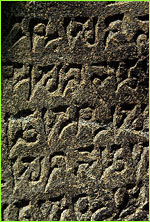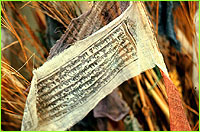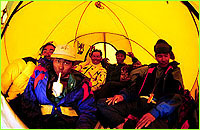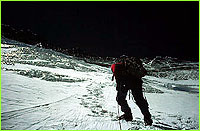
|
 |
 |
 Tenzing Norgay
Tenzing Norgaypart 2 | back to part 1 There was much controversy and political intrigue after Tenzing's summit of Everest, as the Nepalese government wanted him to claim he was Nepalese and the Indian government wanted him to say he was an Indian citizen. In fact, he was both. As he said to the press at the time: "I was born in the womb of Nepal and raised in the lap of India." But most controversial of all was the question of who was truly the first to step atop the summit of Everest—Tenzing or Hillary? For years, people wondered. Even Hillary wrote in his press statement at the time that they reached the summit "almost together." Jamling, as Tenzing's son, was also hounded by truth seekers: "From what I understood from what my father said. . . I've asked that question a couple of times myself because I've been asked it by literally thousands of people. People still ask me. My father's answer was, "We climbed as a team, period."  Jamling carries with him a copy of his father's book,
Tiger of the Snows, The Autobiography of Tenzing of
Everest, so he can read his father's vivid account of his historic
first ascent of Everest while he, too, is on the mountain.
Tenzing's words gradually carry him up Everest toward the
summit: "We are back among the snowy humps. They are curving
off to the right, and each time we pass one I wonder, "Is the
next the last one? Is the next the last?" Finally we reach a
place where we can see past the humps, and beyond them is the
great open sky and brown plains. We are looking down the far
side of the mountain upon Tibet. Ahead of us now is only one
more hump—the last hump. It is not a pinnacle. The way
to it is an easy slope, wide enough for two men to go side by
side. About thirty feet away we stop for a minute and look up.
Then we go on...."
Jamling carries with him a copy of his father's book,
Tiger of the Snows, The Autobiography of Tenzing of
Everest, so he can read his father's vivid account of his historic
first ascent of Everest while he, too, is on the mountain.
Tenzing's words gradually carry him up Everest toward the
summit: "We are back among the snowy humps. They are curving
off to the right, and each time we pass one I wonder, "Is the
next the last one? Is the next the last?" Finally we reach a
place where we can see past the humps, and beyond them is the
great open sky and brown plains. We are looking down the far
side of the mountain upon Tibet. Ahead of us now is only one
more hump—the last hump. It is not a pinnacle. The way
to it is an easy slope, wide enough for two men to go side by
side. About thirty feet away we stop for a minute and look up.
Then we go on...." From that fateful day on, Tenzing has been a symbol of Sherpa
strength and contribution to Himalayan climbing. Sherpas make
up 1/4 of the total ascents of Everest and account for 1/3 of
the lives lost on the mountain. Tenzing's own story on Everest
is what keeps Jamling going. It wasn't until years later that
Tenzing finally revealed exactly who reached the summit first:
"A little below the summit Hillary and I stopped. We looked
up. Then we went on. The rope that joined us was thirty feet
long, but I held most of it in loops in my hand, so that there
was only about six feet between us. I was not thinking of
"first" and "second." I did not say to myself "There is a
golden apple up there. I will push Hillary aside and run for
it." We went on slowly, steadily. And then we were there.
Hillary stepped on top first. And I stepped up after him."
From that fateful day on, Tenzing has been a symbol of Sherpa
strength and contribution to Himalayan climbing. Sherpas make
up 1/4 of the total ascents of Everest and account for 1/3 of
the lives lost on the mountain. Tenzing's own story on Everest
is what keeps Jamling going. It wasn't until years later that
Tenzing finally revealed exactly who reached the summit first:
"A little below the summit Hillary and I stopped. We looked
up. Then we went on. The rope that joined us was thirty feet
long, but I held most of it in loops in my hand, so that there
was only about six feet between us. I was not thinking of
"first" and "second." I did not say to myself "There is a
golden apple up there. I will push Hillary aside and run for
it." We went on slowly, steadily. And then we were there.
Hillary stepped on top first. And I stepped up after him." But perhaps it is his perspective from being on the summit,
his view from the top of the world, that explains why
mountaineers keep climbing Everest: "...around us on every
side, were the great Himalayas, stretching away through Nepal
and Tibet. For the closer peaks—giants like Lhotse,
Nuptse, and Makalu—you now had to look sharply downward
to see their summits. And farther away, the whole sweep of the
greatest range on earth—even Kangchenjunga
itself—seemed only like little bumps under the spreading
sky. It was such a sight as I had never seen before and would
never see again: wild, wonderful and terrible. But terror was
not what I felt. I loved the mountains too well for that. I
loved Everest too well. At that great moment for which I had
waited all my life my mountain did not seem to me a lifeless
thing of rock and ice, but warm and friendly and living."
But perhaps it is his perspective from being on the summit,
his view from the top of the world, that explains why
mountaineers keep climbing Everest: "...around us on every
side, were the great Himalayas, stretching away through Nepal
and Tibet. For the closer peaks—giants like Lhotse,
Nuptse, and Makalu—you now had to look sharply downward
to see their summits. And farther away, the whole sweep of the
greatest range on earth—even Kangchenjunga
itself—seemed only like little bumps under the spreading
sky. It was such a sight as I had never seen before and would
never see again: wild, wonderful and terrible. But terror was
not what I felt. I loved the mountains too well for that. I
loved Everest too well. At that great moment for which I had
waited all my life my mountain did not seem to me a lifeless
thing of rock and ice, but warm and friendly and living."Liesl Clark, NOVA Online's producer and writer, joined the expedition up to Base Camp. Photos: (1) Liesl Clark; (2) courtesy David Breashears; (3) courtesy Sumiyo Tsuzuki; (4) courtesy Ed Viesturs. Lost on Everest | High Exposure | Climb | History & Culture | Earth, Wind, & Ice E-mail | Previous Expeditions | Resources | Site Map | Everest Home Editor's Picks | Previous Sites | Join Us/E-mail | TV/Web Schedule About NOVA | Teachers | Site Map | Shop | Jobs | Search | To print PBS Online | NOVA Online | WGBH © | Updated November 2000 |